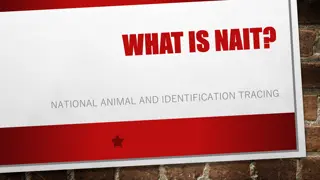
National Animal Identification and Tracing Scheme in New Zealand
The National Animal Identification and Tracing (NAIT) scheme in New Zealand utilizes RFID technology to trace cattle and deer for enhancing biosecurity and food traceability. Discover the reasons behind NAIT's importance, tag technology details, birth tag requirements, and benefits of RFID technology on farms.
Uploaded on | 3 Views
Download Presentation

Please find below an Image/Link to download the presentation.
The content on the website is provided AS IS for your information and personal use only. It may not be sold, licensed, or shared on other websites without obtaining consent from the author. If you encounter any issues during the download, it is possible that the publisher has removed the file from their server.
You are allowed to download the files provided on this website for personal or commercial use, subject to the condition that they are used lawfully. All files are the property of their respective owners.
The content on the website is provided AS IS for your information and personal use only. It may not be sold, licensed, or shared on other websites without obtaining consent from the author.
E N D
Presentation Transcript
The National Animal Identification and Tracing (NAIT) scheme links people, property and livestock in New Zealand. Under the scheme, cattle and deer are traced using NAIT approved radio frequency identification device (RFID) ear tags. Once tagged, these animals are registered in a national database and the details recorded include: The animal's location Movements in the animal's life, and Contact details for the person in charge of that animal. This provides traceability for individual animals, to enhance New Zealand's ability to respond quickly if there is a biosecurity incursion such as a disease outbreak.
3 REASONS WHY THE NEED FOR NAITHAS ARISEN 1. Improving consumer confidence 2. Improving disease management 3. Improving food traceability
TAG TECHNOLOGY TAG TECHNOLOGY Low frequency technology is used for NAIT RFID tags (FDX and HDX tags). This is because it is currently the only proven and commercially available RFID technology for animal identification. There is no proven range of ultra high frequency (UHF) animal tags available locally or internationally. However, the NAIT system is designed to accommodate UHF technology, and would be able to take UHF data in the future. Any introduction of UHF technology for NAIT tags would follow a consultation period to assess costs and benefits.
TAG YOUR ANIMALS Cattle and deer must be tagged with NAIT approved RFID tags. These animals must be tagged within six months of birth, or before they move off farm - whichever is soonest. NAIT tags are the only tags required by law. Animal health board (AHB) approved tags are no longer compulsory, but you should not remove these tags from existing animals. Animals only need one NAIT tag each. You don't need to tag an animal with your own NAIT tag if it already has one. NAIT tags can only be removed with permission from NAIT. NAIT tags cannot be reused for any reason, as each tag has a unique number that identifies a single animal.
Radio Frequency Identification Device (RFID) technology benefits RFID technology enables many on farm benefits, including: automated animal drafting, and recording of individual animal details, such as: Weight Treatments Velvet yield Breeding information, and Milk production. Achieving on farm productivity gains through RFID technology requires further investment, such as RFID reading equipment and computer software suitable for your production type and business needs. This is not mandatory under the NAIT scheme.

